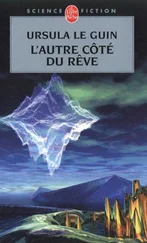I have been back to Mac several times to see Ai Li A Le. It is not a happy plane, or a reassuring one, but I would go to worse places than Islac to see so kind a smile, such a topknot of gold, and to drink maize with the woman who is maize.
THE SILENCE OF THE ASONU is proverbial. The first visitors to their plane believed that these gracious, gracile people were mute, lacking any language other than that of gesture, expression, and gaze. Later, hearing Asonu children chatter, the visitors suspected that among themselves the adults spoke, keeping silence only with strangers. We know now that the Asonu are not dumb, but that once past early childhood they speak very rarely to anyone, under any circumstances. They do not write; and unlike mutes, or monks under vows of silence, they do not use any signs or other devices in place of speaking.
This nearly absolute abstinence from language makes them fascinating.
People who live with animals value the charm of muteness. It can be a real pleasure to know when the cat walks into the room that he won’t mention any of your shortcomings, or that you can tell your grievances to your dog without his repeating them to the people who caused them.
Those who can’t talk, and those who can talk but don’t, have the great advantage over the rest of us in that they never say anything stupid. This may be why we are convinced that if they spoke they would have something wise to say.
Thus there has come to be considerable tourist traffic to the Asonu. Having a strong tradition of hospitality, the Asonu entertain their visitors with generosity and courtesy, though without modifying their own customs.
Some tourists go there simply in order to join the natives in their silence, grateful to spend a few weeks where they do not have to festoon and obscure every human meeting with verbiage. Many such visitors, having been accepted into a household as a paying guest, return year after year, forming bonds of unspoken affection with their quiet hosts.
Others follow their Asonu guides or hosts about, talking to them hour after hour, confiding their whole life to them, in rapture at having at last found a listener who won’t interrupt or comment or mention that his cousin had an even larger tumor than that. As such people usually know little Asonu and speak entirely in their own language, they evidently aren’t worried by the question that vexes some visitors: Since the Asonu don’t talk, do they, in fact, listen?
They certainly hear and understand what is said to them in their own language, since they’re prompt to respond to their children, to indicate directions by gesture to the halting and mispronounced inquiries of tourists, and to leave a building at the cry of “Fire!” But the question remains, do they listen to discursive speech and sociable conversation, or do they merely hear it while keeping silently attentive to something beyond speech? Their amiable and apparently easy manner seems to some observers the placid surface of a deep preoccupation, a constant alertness, like that of a mother who while entertaining her guests or seeing to her husband’s comfort is listening every moment for the cry of her baby in another room.

To perceive the Asonu thus is almost inevitably to interpret their silence as a concealment. As they grow up, it seems, they cease to speak because they are listening to something we do not hear, a secret which their silence hides.
Some visitors to their world are convinced that the lips of these quiet people are locked upon a knowledge which, in proportion as it is hidden, must be valuable—a spiritual treasure, a speech beyond speech, possibly even that ultimate revelation promised by so many religions, and indeed frequently delivered, but never in a wholly communicable form. The transcendent knowledge of the mystic cannot be expressed in language. It may be that the Asonu avoid language for this very reason.
It may be that they keep silence because if they spoke, everything of importance would have been said.
Believers in the Wisdom of the Asonu have followed individuals about for years, waiting for the rare words they speak, writing them down, saving them, studying them, arranging and collating them, finding arcane meanings and numerical correspondences in them, in search of the hidden message. To some, however, these utterances do not seem to be as momentous as one might expect from their rarity. They might even be described as banal.
There is no written form of the Asonu language, and translation of speech is considered to be so uncertain that translatomats aren’t issued to the tourists, most of whom don’t want them anyway. Those who wish to learn Asonu can do so only by listening to and imitating children, who by six or seven years old are already becoming unhappy when asked to talk.
Here are the Eleven Sayings of the Elder of Isu, collected over four years by a devotee from Ohio, who had already spent six years learning the language from the children of the Isu Group. Months of silence occurred between most of these statements, and two years between the fifth and sixth.
1. Not there.
2. It is almost ready [or] Be ready for it soon.
3. Unexpected!
4. It will never cease.
5. Yes.
6. When?
7. It is very good.
8. Perhaps.
9. Soon.
10. Hot! [or] Very warm!
11. It will notecase.
The devotee wove these eleven sayings into a coherent spiritual statement or testament which he understood the Elder to have been making, little by little, during the last four years of his life. The Ohio Reading of the Sayings of the Elder of Isu is as follows:
(1) What we seek is not in any object or experience of our mortal life. We live among appearances, on the verge of the Spiritual Truth. (2) We must be as ready for it as it is ready for us, for (3) it will come when we least expect it. Our perception of the Truth is sudden as a lightning flash, but (4) the Truth itself is eternal and unchanging. (5) Indeed we must positively and hopefully, in a spirit of affirmation, (6) continually ask when, when shall we find what we seek? (7) For the Truth is the medicine for our soul, the knowledge of absolute goodness. (8, 9) It may come very soon. Perhaps it is coming even now in this moment. (10) Its warmth and brightness are as those of the sun, but the sun will perish (11) and the Truth will not perish. Never will the warmth, the brightness, the goodness of the Truth cease or fail us.
Another interpretation of the Sayings may be made by referring to the circumstances in which the Elder spoke, faithfully recorded by the devotee from Ohio, whose patience was equaled only by the Elder’s:
1. Spoken in an undertone as the Elder looked through a chest of clothing and ornaments.
2. Spoken to a group of children on the morning of a ceremony.
3. Said with a laugh in greeting the Elder’s younger sister, returned from a long trip.
4. Spoken the day after the burial of the Elder’s sister.
5. Said while embracing the Elder’s brother-in-law some days after the funeral.
6. Asked of an Asonu “doctor” who was making a “spirit-body” drawing in white and black sand for the Elder. These drawings seem to be both curative and diagnostic, but we know very little about them. The observer states that the doctor’s answer was a short curving line drawn outward from the navel of the spirit-body figure. This, however, may be only the observer’s reading of what was not an answer at all.
7. Said to a child who had woven a reed mat.
8. Spoken in answer to a young grandchild who asked, “Will you be at the big feast, Grandmother?”
Читать дальше










